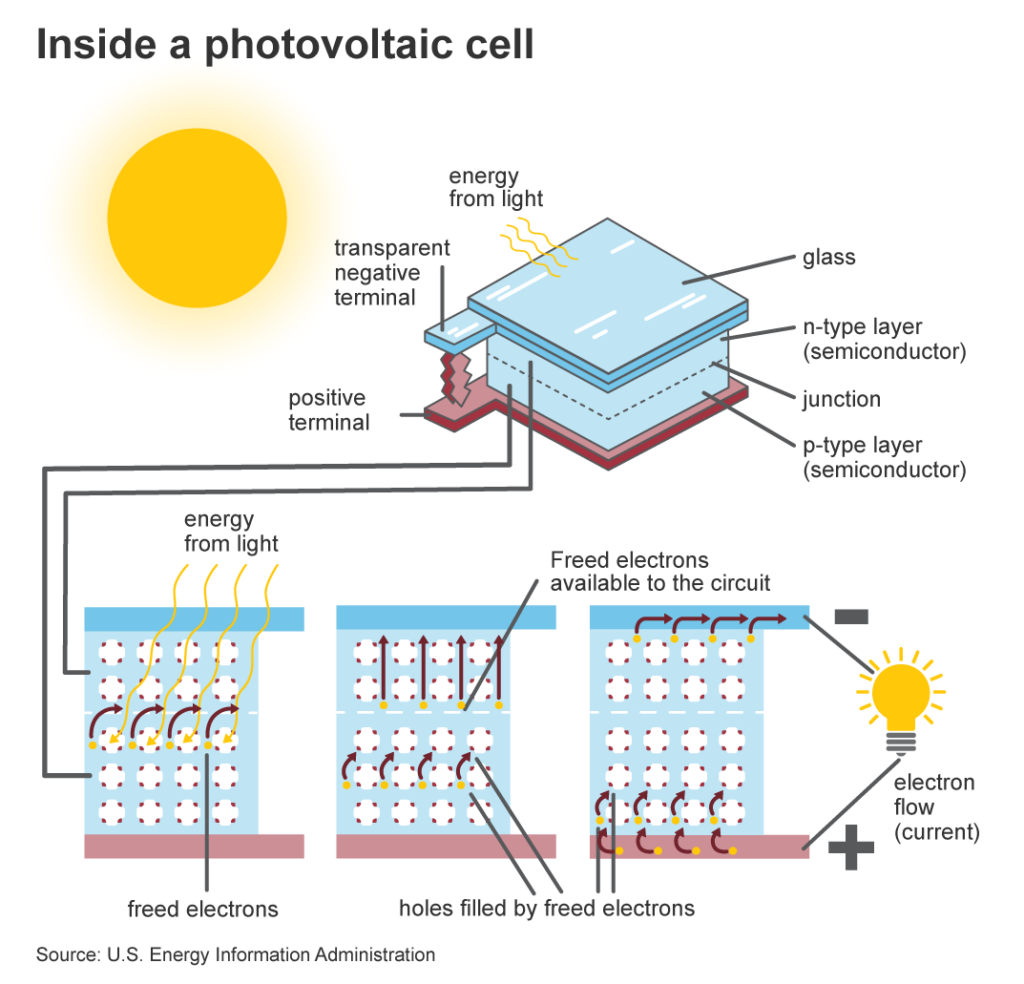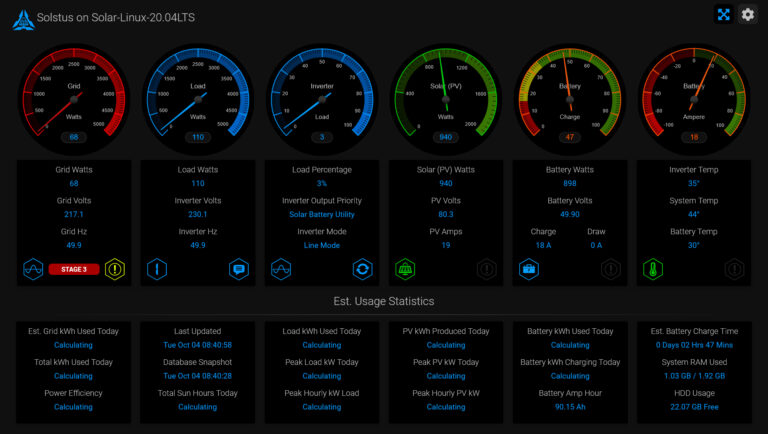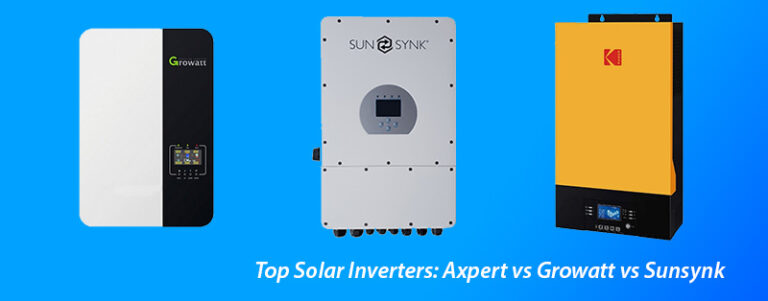Learn more about solar power, also known as solar energy, is a clean and renewable source of energy that harnesses the power of the sun.
It is a technology that has gained significant attention in recent years due to its numerous benefits and potential to address our global energy challenges.
Solar power utilizes photovoltaic (PV) cells to convert sunlight into electricity, providing a sustainable and environmentally-friendly alternative to traditional fossil fuels.

In this article, we will delve into how solar power works, as well as explore the various advantages and applications of this remarkable energy source.
How Does Solar Power Work?
Solar power works by harnessing the energy emitted by the sun through the use of photovoltaic cells. These cells are made up of semiconductor materials that absorb sunlight and convert it into direct current (DC) electricity. The most commonly used semiconductor material in solar panels is silicon.
When sunlight strikes the solar panel, the photons in the sunlight excite the electrons in the silicon atoms, causing them to flow and generate an electric current. This direct current is then converted into alternating current (AC) through an inverter, making it suitable for use in homes, businesses, and industries.

Advantages of Solar Energy
Solar power offers numerous advantages that make it an attractive energy solution. First and foremost, solar power is a renewable energy source, meaning it is inexhaustible and will never run out. Unlike fossil fuels, which contribute to climate change and air pollution, solar power produces no greenhouse gas emissions during operation. This not only helps combat climate change but also improves air quality and reduces health risks associated with pollution.
Additionally, solar power systems require minimal maintenance, as they have no moving parts that can wear out or break down. Once installed, solar panels can last for several decades, providing a reliable and long-lasting source of electricity. Moreover, solar power can be deployed in both centralized and decentralized systems, making it flexible and adaptable to different energy needs.
Environmental Benefits of Solar Power
One of the most significant advantages of solar power is its positive impact on the environment. By harnessing the power of the sun, solar energy reduces our dependence on fossil fuels, which are major contributors to climate change.
Solar power systems produce no greenhouse gas emissions during operation, helping to mitigate global warming and reduce our carbon footprint. Furthermore, solar power reduces air pollution by eliminating the need for burning coal, oil, or natural gas to generate electricity.
This not only improves the quality of the air we breathe but also reduces the occurrence of respiratory diseases and other health issues related to pollution.
Solar power also helps conserve water resources, as it does not require large amounts of water for cooling or steam generation like traditional power plants.
This is particularly important in regions facing water scarcity or drought, where solar power can provide a sustainable and water-efficient energy solution. By embracing solar power, we can protect our environment, preserve natural resources, and create a more sustainable future for generations to come.
Economic Benefits of using Solar
In addition to the environmental advantages, solar power also offers significant economic benefits. As the cost of solar panels and installation continues to decline, solar power has become increasingly affordable and accessible.
This has led to the widespread adoption of solar power systems by homeowners, businesses, and governments around the world. By generating their own electricity from solar power, individuals and organizations can reduce their energy bills and save money in the long run.
Moreover, solar power creates job opportunities and stimulates economic growth. The solar industry has seen substantial job growth in recent years, providing employment in various sectors such as manufacturing, installation, maintenance, and research.
This not only boosts local economies but also contributes to the overall development of the renewable energy sector. Furthermore, solar power reduces the reliance on imported fossil fuels, enhancing energy security and reducing the vulnerability to fluctuations in fuel prices.
By investing in solar power, we can foster economic prosperity while transitioning to a sustainable and resilient energy system.
Solar Power for Residential Use
Solar power is increasingly being utilized for residential purposes, allowing homeowners to generate their own electricity and reduce their reliance on the grid. Residential solar power systems typically consist of rooftop solar panels, an inverter, and a net metering system.
The panels capture sunlight and convert it into electricity, which can be used to power appliances and devices within the home. Any excess electricity generated can be fed back into the grid, earning homeowners credits or monetary compensation through net metering programs.
By installing solar panels on their homes, homeowners can significantly lower their electricity bills and achieve energy independence. They can also take advantage of various incentives and tax credits offered by governments to encourage the adoption of solar power.
Furthermore, residential solar power systems provide a reliable source of electricity during power outages or grid failures, enhancing resilience and ensuring continuity of essential services.
Solar Power for Commercial Use
Beyond residential applications, solar power is also being widely adopted by businesses and industries. Commercial solar power systems can vary in size and complexity, ranging from small rooftop installations to large-scale solar farms.
Regardless of the scale, solar power offers significant benefits for commercial use. By generating their own electricity, businesses can reduce operational costs, increase their energy efficiency, and improve their overall environmental performance.
Commercial solar power systems can also serve as an effective marketing tool, showcasing a company’s commitment to sustainability and renewable energy.
Many consumers and investors are increasingly prioritizing environmental responsibility and are more likely to support businesses that embrace clean energy solutions. Additionally, the installation of solar panels can enhance the value of commercial properties, making them more attractive to potential tenants or buyers.
Solar Power in Developing Countries
Solar power has immense potential in developing countries, where access to electricity is limited or unreliable. Many remote and under-served communities around the world still lack access to the grid, relying on expensive and polluting sources of energy such as diesel generators. Solar power can provide a viable and sustainable solution to meet their energy needs.
Off-grid solar power systems, also known as solar home systems, are particularly beneficial in these contexts. These systems consist of solar panels, batteries for energy storage, and efficient appliances. They can power lights, small appliances, and even provide charging capabilities for mobile phones.
Thus by using solar power developing countries can improve the quality of life for their citizens, stimulate economic development, and reduce carbon emissions.
Furthermore, in countries like South Africa where daily power cuts known as load shedding is happening daily, solar power can help reduce or even negate the effects of having up to 12 hours a day power outages. Over the last 10 years there has been a substantial uptake on solar adoption both in the residential and commercial space.
Challenges and Limitations of Solar Power
While solar power offers numerous advantages, it is not without its challenges and limitations. One of the primary limitations of solar power is its intermittent nature. Solar panels only generate electricity when exposed to sunlight, which means they are unable to produce electricity during cloudy days or at night. This necessitates the use of energy storage systems, such as batteries, to store excess electricity for use during periods of low or no sunlight.
Another challenge is the requirement of a substantial initial investment for the installation of solar power systems. While the cost of solar panels has decreased significantly in recent years, the upfront costs can still be prohibitive for some individuals or organizations. However, it is important to note that the long-term savings and benefits of solar power often outweigh the initial investment.
Additional Components Needed to Make a Full Solar System Work
Solar Panels – Capturing Sunlight with Precision
Selecting the right solar panels is pivotal in ensuring optimal energy generation and long-term reliability for your solar system.
When considering solar panel options, the choice between monocrystalline (mono) and polycrystalline (poly) panels often arises.
Monocrystalline
Monocrystalline panels are crafted from single-crystal silicon, offering higher efficiency and a sleeker appearance due to their uniform black color.
With their superior efficiency, monocrystalline panels require less space to generate the same amount of power as polycrystalline panels, making them ideal for installations with limited roof space.
Additionally, monocrystalline panels tend to perform better in low-light conditions, ensuring consistent energy production even during overcast days.
Polycrystalline
On the other hand, polycrystalline panels are made from multiple silicon fragments, resulting in a bluish hue and slightly lower efficiency compared to monocrystalline counterparts. However, poly panels typically come at a lower cost, making them a budget-friendly option for larger installations where space is not a limiting factor.
While monocrystalline panels offer higher efficiency and better performance in limited space, polycrystalline panels provide a cost-effective solution for larger installations with ample roof or ground space.
Inverters – Transforming Sunlight into Usable Energy
Inverters play a crucial role in solar energy systems by converting the direct current (DC) generated by solar panels into alternating current (AC) suitable for powering household appliances and feeding into the electrical grid.
There are three main types of inverters commonly used in solar installations: string inverters, microinverters, and power optimizers.
String inverters
String inverters are the most traditional type and are typically installed in larger solar systems. They connect multiple solar panels in a series, converting the combined DC output into AC electricity. While string inverters are cost-effective and simple to install, they are susceptible to performance issues if one panel in the string is shaded or experiences a malfunction.
Microinverters
Microinverters, on the other hand, are installed on each individual solar panel, converting DC to AC at the panel level. This allows each panel to operate independently, maximizing energy production even in shaded or partially obstructed conditions.
Microinverters offer greater flexibility and performance monitoring capabilities compared to string inverters, but they are generally more expensive and require additional installation time.
Power Optimizers
Power optimizers represent a hybrid solution, installed at the panel level like micro-inverters but working in conjunction with a central string inverter.
They optimize the power output of each panel and mitigate the effects of shading or panel mismatch, improving overall system performance.
Power optimizers strike a balance between the cost-effectiveness of string inverters and the performance benefits of micro-inverters, making them a popular choice for many solar installations.
By understanding the characteristics and capabilities of each type of inverter, solar enthusiasts can select the option that best suits their specific energy needs, budget constraints, and installation requirements, ensuring optimal performance and efficiency for their solar energy systems.
Batteries – Storing Solar Energy for Continuous Usage
Batteries play a pivotal role in solar energy systems by storing excess electricity generated during peak sunlight hours for use during periods of low or no sunlight, such as nighttime or cloudy days.
There are a few different types of batteries commonly used in solar installations, each with its own unique characteristics, advantages, and limitations.
Lead-Acid Batteries:
Lead-acid batteries are one of the oldest and most widely used types of batteries in solar applications.
They are affordable and readily available, making them a popular choice for off-grid and grid-tied solar systems. Lead-acid batteries are available in two main variants: flooded (wet cell) and sealed (valve-regulated lead-acid, or VRLA).
Flooded lead-acid batteries require periodic maintenance, including topping up electrolyte levels with distilled water, while sealed lead-acid batteries are maintenance-free and suitable for locations where maintenance is challenging.
Lithium-Ion Batteries:
Lithium-ion batteries have gained significant popularity in recent years due to their high energy density, longer lifespan, and superior performance compared to lead-acid batteries.
These batteries offer faster charging times, deeper discharge capabilities, and a longer cycle life, making them ideal for both off-grid and grid-tied solar systems.
Within the category of lithium-ion batteries, there are various chemistries, including lithium iron phosphate (LiFePO4), lithium cobalt oxide (LiCoO2), and lithium manganese oxide (LiMn2O4), each with its own set of characteristics and applications.
Flow Batteries:
Flow batteries, also known as redox flow batteries, are a type of rechargeable battery where energy is stored in chemical compounds dissolved in liquid electrolytes.
They are particularly well-suited for grid-scale energy storage and renewable energy integration due to their ability to store and discharge energy over extended periods without degradation.
Sodium-Based Batteries:
Sodium-based batteries, such as sodium-ion and sodium-sulfur batteries, are emerging as promising alternatives to lithium-ion batteries for stationary energy storage.
These batteries utilize abundant and inexpensive sodium as the charge carrier, offering potential cost advantages over lithium-based chemistries.
Sodium-based batteries are being developed for various applications, including residential and commercial energy storage, where cost-effectiveness and sustainability are paramount.
Monitoring Systems – Maximizing Efficiency through Data Insights
Monitoring systems are essential components of solar energy systems, providing real-time insights into system performance, energy production, and overall efficiency.
There are several types of monitoring systems commonly used in solar installations, each offering unique features and capabilities to optimize system operation and maintenance. Here are some of the main types:
Web-Based Monitoring Platforms:
Web-based monitoring platforms allow users to remotely access and monitor their solar energy systems via the internet.
These platforms typically provide comprehensive data visualization tools, performance analytics, and alert notifications to keep users informed about their system’s performance in real-time.
Users can track energy production, monitor system health, and identify potential issues or anomalies from any internet-enabled device, providing convenience and peace of mind.
Micro Fusion’s Solstus IoT Monitoring system offers an excellent array of features to monitor and control your Solar system if it uses an Axpert type inverter…
Inverter-Integrated Monitoring:
Many modern solar inverters come equipped with built-in monitoring capabilities, allowing users to track energy production and system performance directly from the inverter’s interface or through a smartphone app.
Inverter-integrated monitoring systems offer basic performance metrics and fault detection features, enabling users to troubleshoot issues and optimize system efficiency without the need for additional monitoring equipment.
Energy Metering Systems:
Energy metering systems measure and record energy consumption and production data at the meter level, providing granular insights into energy usage patterns and solar generation.
These systems typically integrate with solar inverters and utility meters to monitor energy flows in real-time, enabling users to track energy savings, assess system performance, and optimize energy usage behaviors.
Data Logger Devices:
Data logger devices are standalone monitoring units that collect and store data from various sensors and monitoring equipment installed within a solar energy system.
These devices record parameters such as solar irradiance, temperature, voltage, and current, allowing users to analyze historical data trends, diagnose performance issues, and optimize system design and operation.
Third-Party Monitoring Services:
Some solar system owners opt for third-party monitoring services offered by solar installers, manufacturers, or independent monitoring companies.
These services typically involve remote monitoring and proactive maintenance support, where experienced professionals monitor system performance, analyze data trends, and provide recommendations for optimizing energy production and system reliability.
The Future of Solar Power
The future of solar power looks promising, with ongoing technological advancements, increased efficiency, and decreasing costs.
Researchers and scientists are constantly working on improving solar panel efficiency, finding new materials, and developing innovative technologies to enhance the performance and scalability of solar power systems.
This includes the development of advanced photovoltaic cells, such as thin-film solar cells and multi-junction solar cells, which can achieve higher conversion efficiencies.
Furthermore, the integration of solar power with other renewable energy sources, such as wind power and energy storage systems, can help address the intermittent nature of solar power and ensure a steady and reliable supply of electricity.
The adoption of smart grid technologies and digital solutions can also enable better management and optimization of solar power systems.
Conclusion
Solar power is a remarkable and sustainable energy source that offers numerous benefits for individuals, businesses, and the environment. By harnessing the power of the sun, we can reduce our dependence on fossil fuels, mitigate climate change, improve air quality, and stimulate economic growth.
Solar power is versatile and can be harnessed for residential, commercial, and off-grid applications, making it accessible to a wide range of users.
While there are challenges and limitations associated with solar power, ongoing advancements in technology and decreasing costs make it a promising solution for our future energy needs. Embracing solar power is a step towards a cleaner, greener, and more sustainable world.
CTA: To learn more about solar power and explore solar energy solution software, visit Micro Fusion’s Solstus Project.




Pingback: Crypto, Bitcoin Guide: Secure Your Digital Wealth - Micro Fusion Insight
Pingback: Setting up a simple virtual machine to run Windows 11 - Micro Fusion Insight